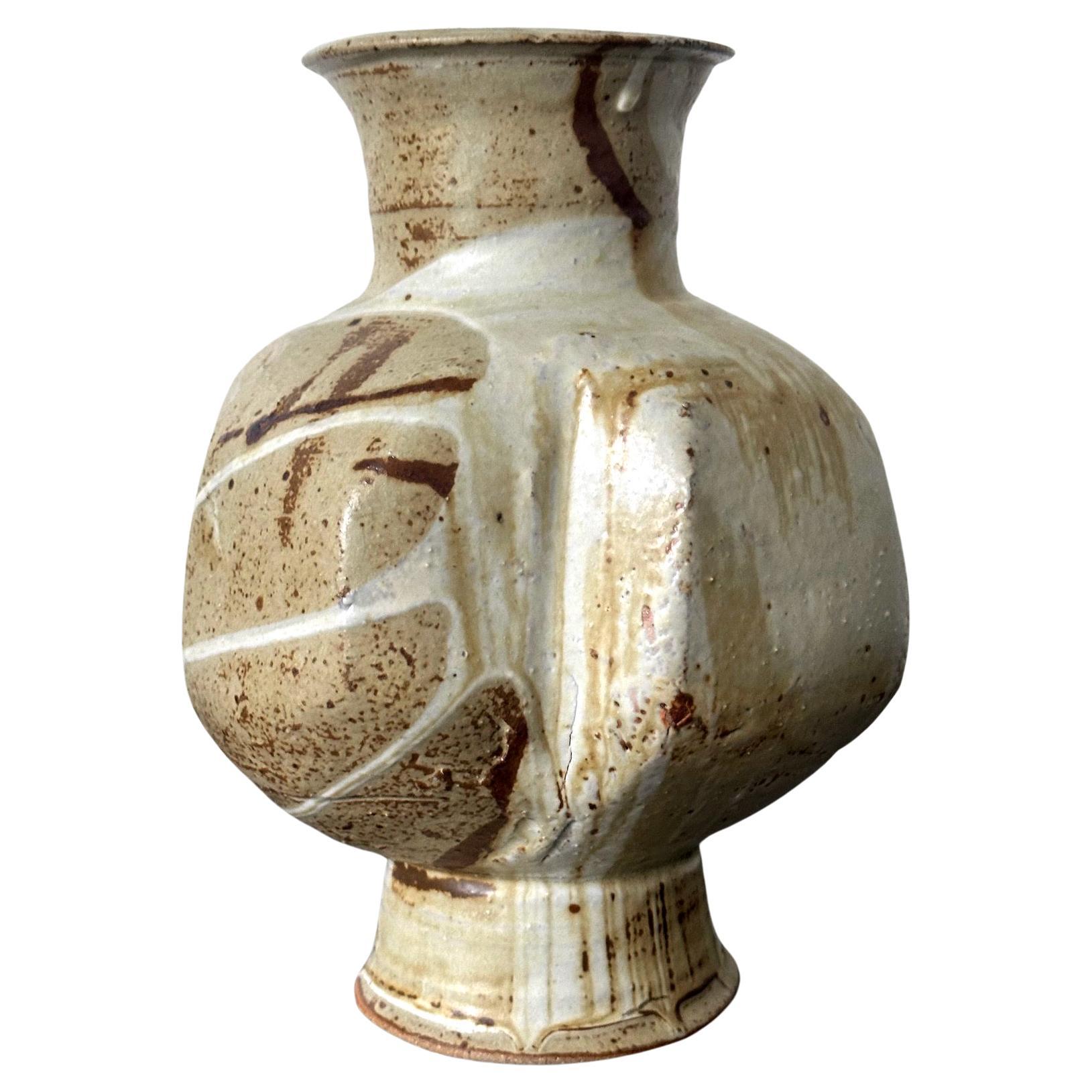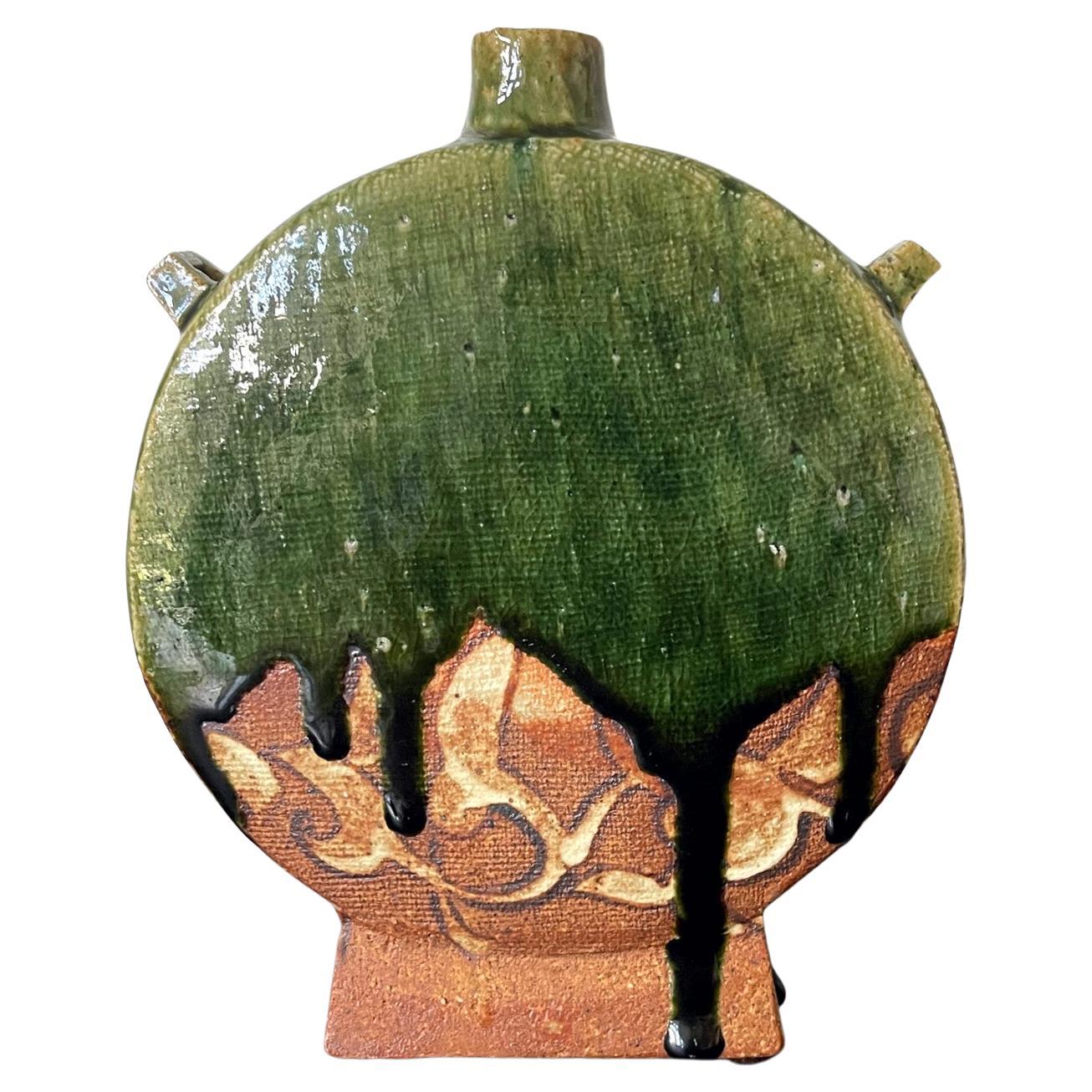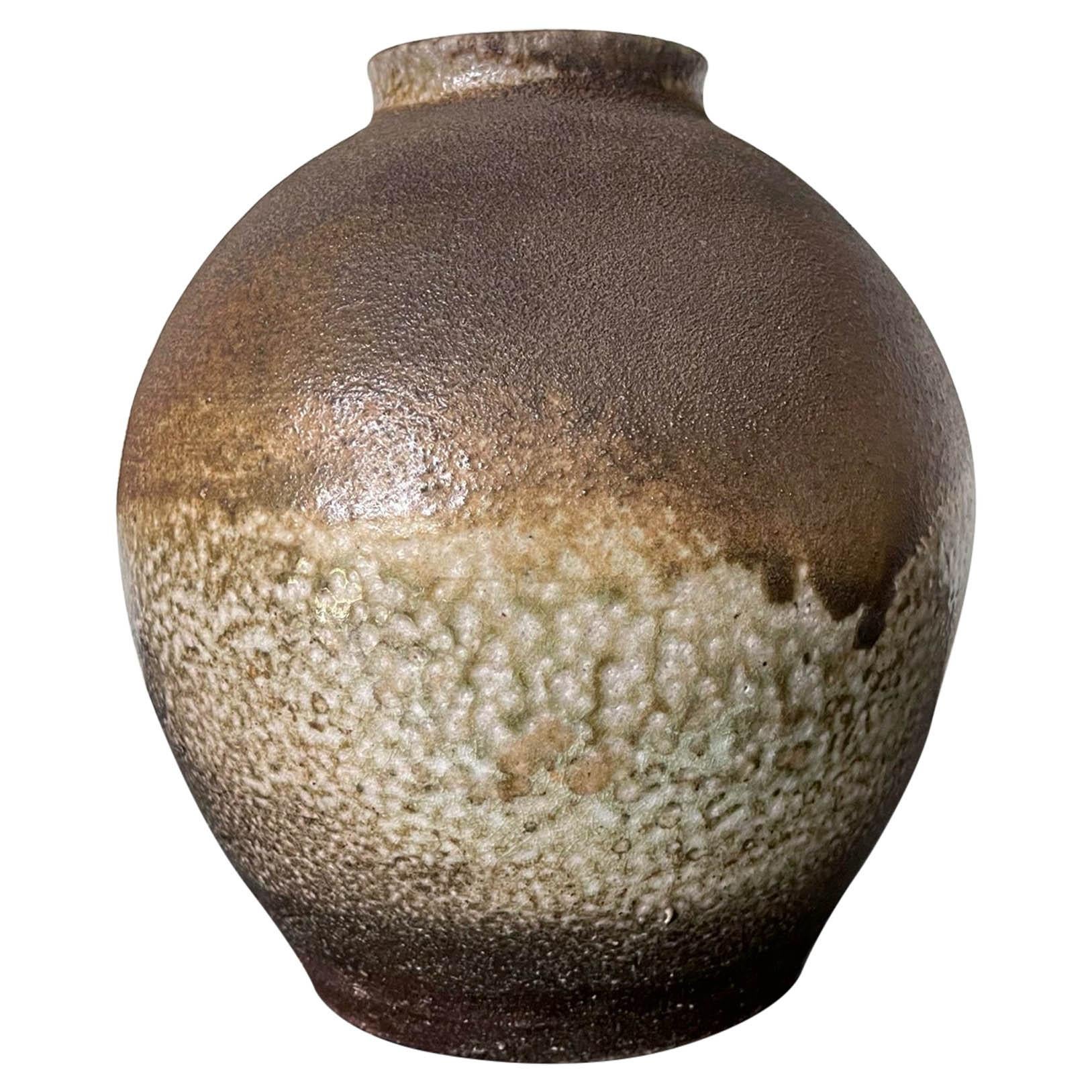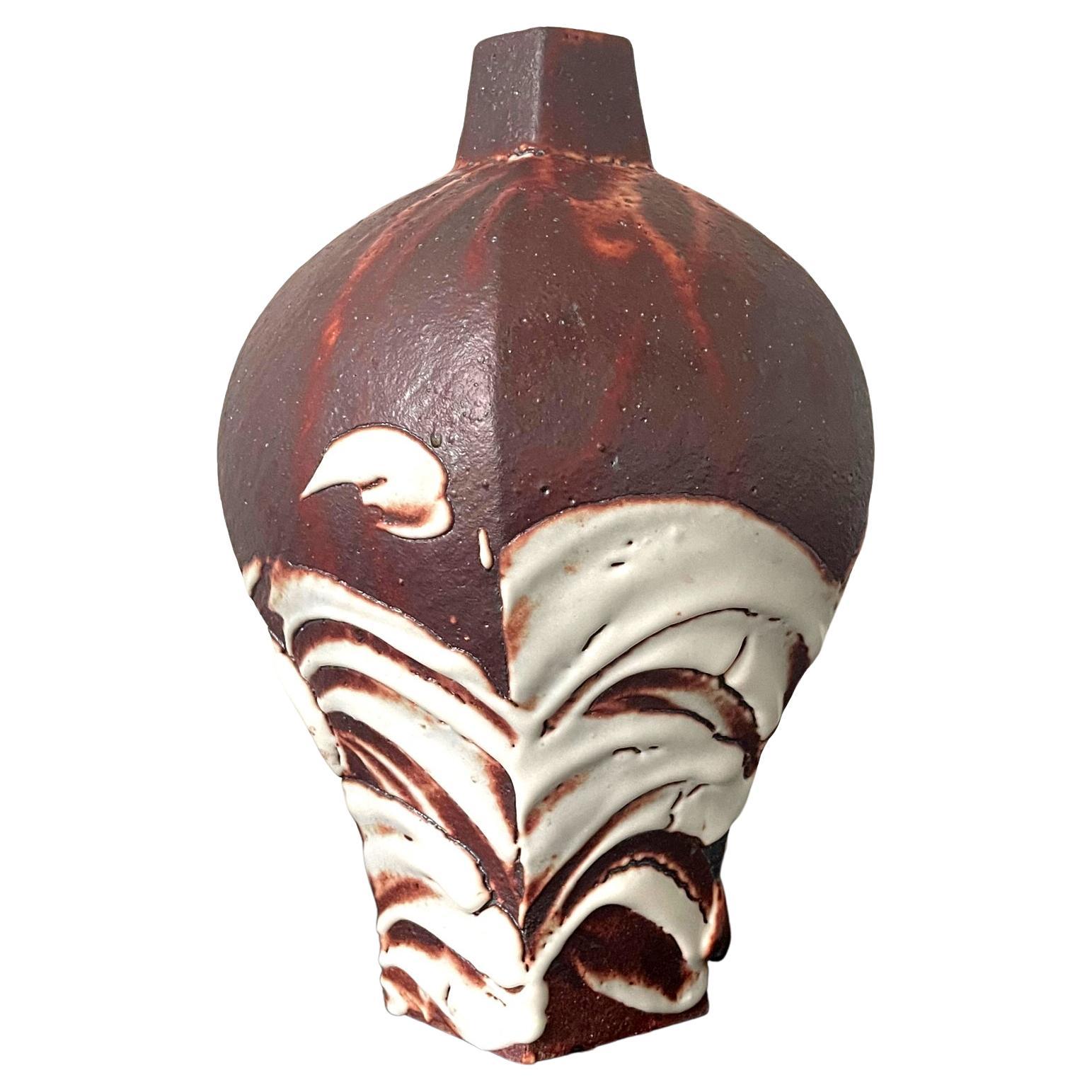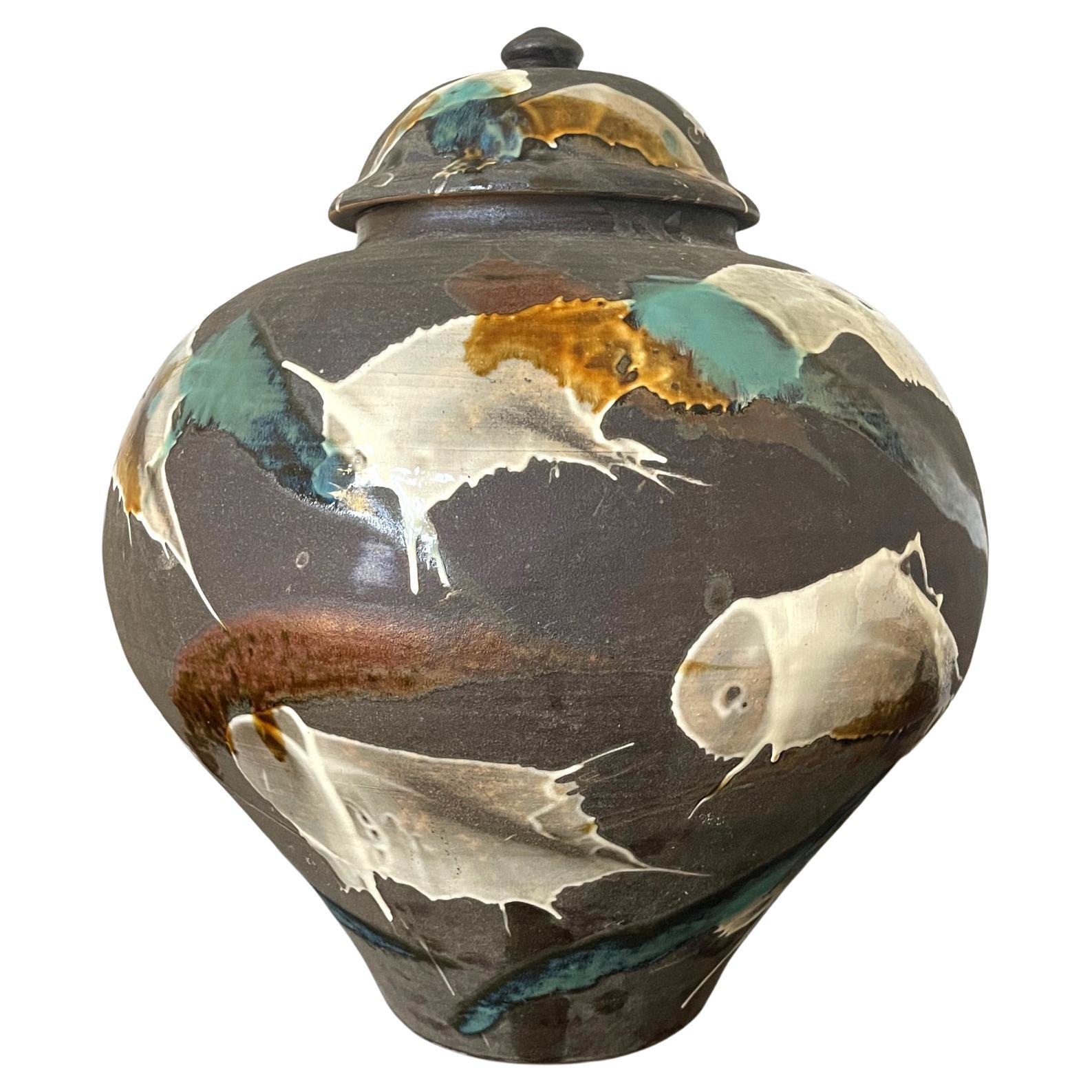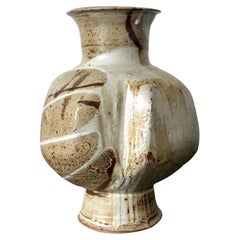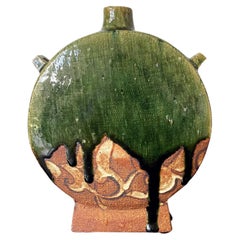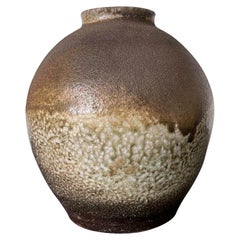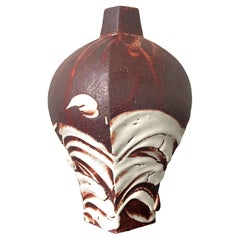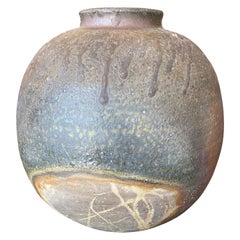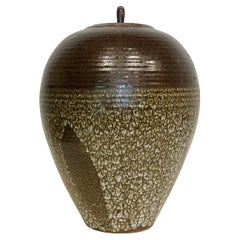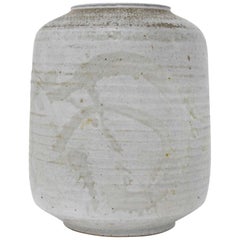Items Similar to Japanese Modern Studio Ceramic Oribe Jar by Ryoji Koie
Want more images or videos?
Request additional images or videos from the seller
1 of 19
Japanese Modern Studio Ceramic Oribe Jar by Ryoji Koie
$6,000
£4,552.66
€5,205.56
CA$8,380.37
A$9,317.83
CHF 4,865.26
MX$113,420.74
NOK 62,078.59
SEK 58,164.67
DKK 38,850.07
Shipping
Retrieving quote...The 1stDibs Promise:
Authenticity Guarantee,
Money-Back Guarantee,
24-Hour Cancellation
About the Item
A glazed ceramic vessel by Japanese potter Ryoji Koie (1938-2020). Hand-built with intention to be seen as such, the tsubo has a primordial irregular form with a small opening and a swelled body resembling a beehive. The upper body was covered in a glassy green oribe glaze with fine crackles, highlighted with three incised geometrical symbols. The lower body is unglazed and exposed the white clay with marks of the hand-making pinches and kneading along the base. The base also shows highly irregular surface due to the seashell spur marks and clay pitting in the kiln during the firing process. All these occurrences honestly preserved and presented as part of the character of this wonderful modern piece. The jar comes with a plain wooden tomobako box.
"One of Japan’s most versatile and forward-thinking contemporary artists, KOIE RYOJI was best known as a ceramist but esteemed for his two-dimensional artwork as well. His love of experimentation led to his creation of “ceramic happenings,” with themes that were social and often political critiques of the horrors of the 20th century. Born in 1938 in Tokoname, one of the oldest ceramic centers in Japan, Koie studied ceramics locally but almost immediately developed his iconoclastic style. Rather than labor to preserve tradition, as a young man, he looked to movements in postwar contemporary art such as the abstract expressionist paintings of Jackson Pollock and the found-object ethos of Mono-ha. The gestural application of glazes on his ceramics created dynamic surfaces that reflected this innovative approach. His works can be found in the permanent collections of prominent museums on five continents."
Courtesy from Joan B. Mirviss LTD.
- Creator:Ryoji Koie (Artist)
- Dimensions:Height: 8 in (20.32 cm)Diameter: 8 in (20.32 cm)
- Style:Modern (Of the Period)
- Materials and Techniques:Ceramic,Glazed
- Place of Origin:
- Period:
- Date of Manufacture:2000s
- Condition:Wear consistent with age and use. Fine condition, some intended glaze dripping from making process. Base as shown not chipped but made as it is.
- Seller Location:Atlanta, GA
- Reference Number:1stDibs: LU945028780682
About the Seller
4.9
Platinum Seller
Premium sellers with a 4.7+ rating and 24-hour response times
Established in 2006
1stDibs seller since 2010
564 sales on 1stDibs
Typical response time: <1 hour
- ShippingRetrieving quote...Shipping from: Atlanta, GA
- Return Policy
Authenticity Guarantee
In the unlikely event there’s an issue with an item’s authenticity, contact us within 1 year for a full refund. DetailsMoney-Back Guarantee
If your item is not as described, is damaged in transit, or does not arrive, contact us within 7 days for a full refund. Details24-Hour Cancellation
You have a 24-hour grace period in which to reconsider your purchase, with no questions asked.Vetted Professional Sellers
Our world-class sellers must adhere to strict standards for service and quality, maintaining the integrity of our listings.Price-Match Guarantee
If you find that a seller listed the same item for a lower price elsewhere, we’ll match it.Trusted Global Delivery
Our best-in-class carrier network provides specialized shipping options worldwide, including custom delivery.More From This Seller
View AllCeramic Vase with Bespoken Glaze by Makoto Yabe
By Makoto Yabe
Located in Atlanta, GA
Made by Japanese ceramic artist Makoto Yabe (1947-2005), this stoneware vase features a globular body supported by a round pedestal foot. A similarly shaped neck extends to a rimmed mouth opening. Robust in form with thick wall, the vase is noted for its irregular cloved form. The surface is covered in a beige-yellow glaze, on top of which, dark brown strokes and thick white feldspar slip were artistically applied in a splashed and washed pattern. Together with some random shallow incision lines, they form an abstract painting with textured surface where some slip forms small droplets at the end of the stroke. The work was created in traditional Japanese manner and reflects the beauty of Wabi Sabi, a Zen aesthetic for the imperfect perfection.
The base was incised with the artist's cipher.
"Makoto Yabe's work beautifully exemplifies the transmission of Japanese ceramics to the West. Born in Fukushima, Japan, Yabe began studying ceramics in Kyoto at the age of nine. He completed his training at the age of 24, with a four-year apprenticeship under Jinmatsu Uno and Sango Uno. Yabe then came to Boston, where he was an integral member of the local ceramic community, yet he maintained his Japanese roots. As an instructor of ceramics, Yabe worked in the Boston area at numerous schools and universities, touching the lives of all his students and expanding their knowledge and appreciation of studio ceramics."
Biography sited from Pucker Gallery...
Category
Late 20th Century American Organic Modern Ceramics
Materials
Ceramic, Stoneware
Modern Japanese Studio Pottery Oribe Moon Flask Vase by Ken Matsuzaki
By Ken Matsuzaki
Located in Atlanta, GA
A contemporary studio ceramic vase made by Japanese potter Ken Matsuzaki (1950-). The vase showcases distinguished "moon flask" form with shoulder loops. The moon flask form was widely recorded first in Tang Dynasty China, most likely arrived from the Mideast countries via the silk road. It was originally used as drink vessel for the nomads and the loops were used to tie it to the horse-centered owner. The exotic form persisted in Chinese ceramic production through Ming to Qing dynasty. The form is unusual in Ken Matsuzaki's work. The artist covered the vase with a thick dripping Oribe green glaze partially revealing the unglazed part of the body, which is decorated with scrolling pattern in left by ash glaze. The work is rooted in both Yohen Shino glaze technique and Oribe tradition, but interestingly it also paid homage to Sancai pottery in Tang Dynasty when green glaze was prominently used to drip and splash onto the pottery. Viewing the vase, one can see in this harmonious piece, the innovative reinterpretation of ancient aesthetics that cross the cultures, geology and time. The base is marked with the artist's signature. The vase comes with an inscribed tomobako storage box with the artist's bio and wrapping cloth with seal. The vase measures 8.6"h x 7"w x 2"d.
Ken Matsuzaki’s haptic ceramics bring a contemporary approach to traditional Japanese ceramicware, most notably 16th-century Oribe pottery...
Category
Early 2000s Japanese Modern Ceramics
Materials
Ceramic
Japanese Shigaraki Jar for Ikebana by Shiho Kanzaki
By Shiho Kanzaki
Located in Atlanta, GA
A Shigaraki stoneware jar by Japanese potter Shino Kanzaki (1942-2018). Kanzaki is a world renowned potter in Shigaraki who based his modern work on the ancient tradition of Shigaraki and Iga ware...
Category
20th Century Japanese Modern Ceramics
Materials
Ceramic
Japanese Studio Ceramic Vase by Ken Matsuzaki with Original Tomobako
By Ken Matsuzaki
Located in Atlanta, GA
An impressive stoneware bottle form vase by contemporary Japanese studio potter Ken Matsuzaki (1950-) circa 2010s. The solid form takes its cue from Chinese traditional plum vase (Meiping) with raised and swelled shoulder and a small opening, yet it rises from a non-conventional pentagonal faceted base. The extraordinary surface was covered with Yohen Shino glaze in a deep iron hue. Thick white slips were applied in bold strokes to the lower portion of the vase. The abstract pattern calls to mind of the imagery of the iconic ocean waves found in traditional Japanese art. The presence of the vase is strong and none-compromising, reaching back to the past yet appearing utterly modern. It is marked by the artist underneath and comes with the original tomobako with title and author inscriptions and a wrapping cloth with the artist's seal.
"Ken Matsuzaki’s haptic ceramics bring a contemporary approach to traditional Japanese ceramicware, most notably 16th-century Oribe pottery...
Category
21st Century and Contemporary Japanese Modern Ceramics
Materials
Ceramic
Large Japanese Contemporary Ceramic Jar from Onda Yaki Kiln
By Onda Yaki
Located in Atlanta, GA
A large Japanese lidded ceramic jar from the kiln of Onda Yaki, circa 2010. The stoneware jar impresses the viewer with a robust bulbous form. Its black body is nearly unglazed but exuberantly splashed with strokes of slip glazes of white, yellow and blue. The visual effect is wonderful that it appears traditional and contemporary at the same time. The tri-color glaze calls to mind the San-Cai from Chinese Tang dynasty, yet the application is akin to abstract painting on canvas.
Onda Yaki also spelled as Onta Yaki also spelled Onta, is a type of Japanese pottery produced in and around the village of Onta in Oita Prefecture in Kyushu Island. It was founded in 1705. Closely associated with Mingei folk art, Onda ware was inscribed by the national government in 1995 as an Intangible Cultural Property
Background from Pucker Gallery where the jar was exibited and purchased.
"In his search for true folk pottery, the Japanese philosopher Soetsu Yanagi...
Category
2010s Japanese Organic Modern Ceramics
Materials
Ceramic
Large Japanese Ceramic Oribe Sculptural Vessel by Shigemasa Higashida
Located in Atlanta, GA
A large ceramic lidded vessel with striking sculptural form by contemporary Japanese potter Shigemasa Higashida (1955-). Hand-built and with drasti...
Category
Early 2000s Japanese Modern Ceramics
Materials
Ceramic
You May Also Like
Izuru Yamamoto Japanese Bizen Ware Pottery Yohen Tsubo Jar Vase With Ash Glaze
Located in Studio City, CA
A stunning and sumptuously, naturally glazed large work by Japanese pottery master Izuru Yamamoto (Born 1944- He is the son of the late Toshu Yamamoto- a Japanese Living National Tr...
Category
21st Century and Contemporary Japanese Ceramics
Materials
Pottery, Stoneware
Vintage Japanese Ceramic Lidded Vessel c1970s
Located in Oakland, CA
Absolutely stunning tapered turned studio clay vessel with a beautifully sculpted lid. Amazing glaze work with cascading puffy drips. Really a handsome piece. Signed by maker.
Category
Vintage 1970s Japanese Modern Vases
Materials
Clay
Clyde Burt Ceramic Vessel or Vase
By Clyde Burt
Located in Dallas, TX
Born in Melrose, Ohio in 1922, Clyde Burt would go on to become a major voice in American studio ceramics. He studied at Fort Wayne Art School and later at the Cape Cod School of Art before landing at the Cranbrook Academy of Art to study under Maija Grotell. While Grotell is responsible for bringing the wheel to Cranbrook, Burt made it central to his practice and his thrown works express the same endless curiosity as his teacher. Upon returning to Ohio, Burt built a home studio on his family’s farmland near the Little Auglaize River and harvested rich clay from the surrounding area. He started every day at 5:30 in the morning and would work until he knew he “had enough”. Constantly experimenting with glazes, colors and surface decoration, Burt painstakingly recorded his successes and failures in a small notebook...
Category
Mid-20th Century North American Mid-Century Modern Vases
Materials
Ceramic
Stoneware Vase by Swedish Ceramist Rolf Palm, 1981
Located in Malmö, SE
A beautiful and unique stoneware vase with amazing glaze.
Made by Rolf Palm, in the artist's studio, Mölle, Sweden, 1981.
Excellent condition. Incised ’Palm / Mölle / H0’ and ma...
Category
Mid-20th Century Swedish Scandinavian Modern Vases
Materials
Ceramic, Stoneware
19th Century Japanese Stoneware Saki Jar Vessel
Located in Miami, FL
A large heavily glazed stoneware saki jar or pot.
This traditional Japanese piece has wonderful colors and a beautiful shape, 19th century.
Category
Antique 19th Century Japanese Jars
Materials
Ceramic
Awaji Pottery Manipulated Jar Heavy Drip Lava Glaze Wabi Sabi Tea Ceremony Vase
By Awaji Pottery
Located in Wilton, CT
Awaji Pottery jar with dents and slashes covered in layers of thick lava glaze, circa 1930. Impressed export mark. Measures: 8 1/2" high, 9" diameter. Excellent condition.
Category
Vintage 1930s Japanese Art Deco Vases
Materials
Stoneware
More Ways To Browse
Modern Studio Ceramics
Japanese 20th Century Modern Furniture
Kiln Japanese
Abstract Japanese Ceramics
Wooden Jars
Japanese Wooden Box
Japanese Crackle
Green Jar Japan
Beehive Mark
Seashell Collection
Crackle Jar
Ceramic Seashell
Seashell Box
Unglazed Clay Jar
Japanese Oribe
Japanese Tsubo
Ceramic Beehive
Oribe Ceramics
